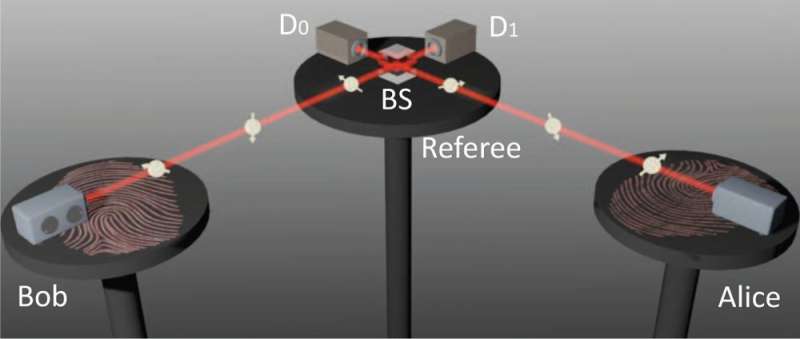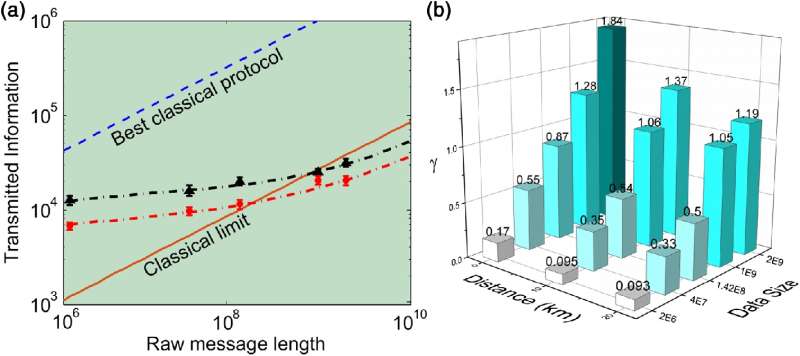July 5, 2016 feature
Quantum fingerprinting surpasses classical limit

(Phys.org)—As the saying goes, no two fingerprints are alike, and the same is true for quantum fingerprints. Just as a human fingerprint is only a fraction of the size of a person, yet can be used to distinguish between any two people (at least in theory), quantum fingerprints are exponentially smaller than the string of information they represent, yet they can be used to distinguish between any two strings.
Ever since quantum fingerprinting was first proposed in 2001, it has for the most part remained an interesting theoretical concept, with only a handful of protocols having managed to experimentally demonstrate the idea.
Now in a new study, researchers have experimentally demonstrated a quantum fingerprinting protocol and shown that it can surpass the classical limit for solving communication complexity problems. In these problems, two parties each have a message, and they both share some of their message with a referee, who has to decide whether the two messages are the same or not. The classical limit requires that a minimum amount of information must be transmitted between each party and the referee in order for the referee to make this decision.
So far, the best communication complexity protocols have required transmitting an amount of data that is two orders of magnitude larger than the classical limit.
Now in the new study, the scientists showed that quantum fingerprinting can transmit less information than that required by the classical limit, in some cases up to 84% less, by transmitting only the tiny amount of information that is contained in a quantum fingerprint. The results set a new record for transmitting the smallest amount of information for any type of communication complexity protocol.
"For the first time, we have demonstrated the quantum advantage over classic information processing in communication complexity," coauthor Qiang Zhang, a physicist at the University of Science and Technology of China and the Jinan Institute of Quantum Technology, told Phys.org.

The key to experimentally realizing the quantum fingerprinting protocol is the ability to distinguish between any two strings of quantum information just by knowing their quantum fingerprints. To do this, the researchers transmitted the quantum fingerprints in the form of single-photon pulses to two detectors. If the two fingerprints/pulses are different, both detectors click; if they're identical, only one of the detectors clicks.
The achievement could lead to a wide variety of applications in quantum communications, in particular the potential for the development of "green" (low-energy) communication methods.
The results could also lead to new tests of the foundations of quantum physics, since quantum fingerprinting involves quantum phenomena such as nonlocality, which is related to quantum entanglement.
Demonstrating the potential for applications, the researchers used the new protocol to transmit 2-Gbit video files over a 20-km fiber. By transmitting only the information contained in the files' quantum fingerprints, this task requires transmitting only about 1300 photons, which is 14% less information than that required by the classical limit.
However, the researchers note that the new protocol cannot be used for any real-world application—including sending video files—in its current form, since it still needs improvement in several areas. One drawback is that the new protocol takes more time to run than classical protocols, even though it uses less energy overall. Also, the number of transmitted photons required increases as the channel distance increases, so the quantum advantage diminishes over longer distances. The researchers plan to address these drawbacks in future work.
"Although our setup utilizes less information compared to the classical limit, it takes more time and more channel resources," Zhang said. "So we cannot find its application in its current status. We may try to improve the transmission time by using multiplexing. But we do not whether it will be useful."
More information: Jian-Yu Guan et al. "Observation of Quantum Fingerprinting Beating the Classical Limit." Physical Review Letters. DOI: 10.1103/PhysRevLett.116.240502
Journal information: Physical Review Letters
© 2016 Phys.org




















